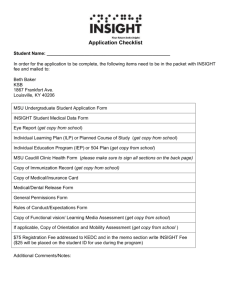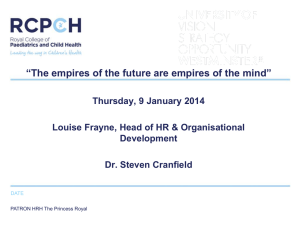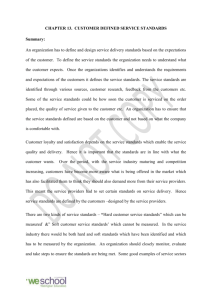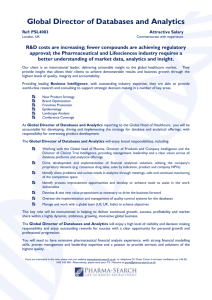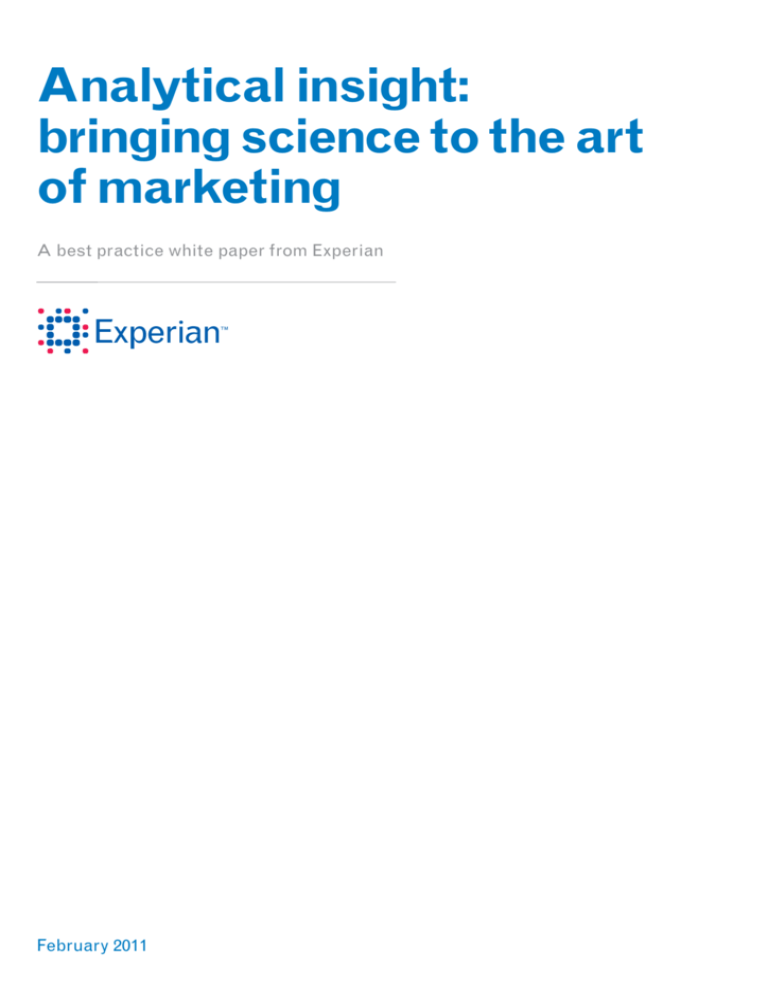
Analytical insight:
bringing science to the art
of marketing
A best practice white paper from Experian
February 2011
Introduction
With marketing under constant pressure to
innovate and compete, the lion’s share of your
effort is understandably directed at the execution
of your go-to-market strategy –whether it’s
product development, packaging, promotion or
communications.
You may view number-crunching simply as a means to an end. Perhaps that’s why
the value of data to the marketing function has historically been underestimated
– more so than in sales, finance or operations, where numbers have always visibly
driven business decisions.
However, in these cost-conscious times, static or shrinking budgets no longer
indulge an experimental approach to marketing. You’re expected to be able to
directly attribute ROI to specific initiatives to justify further campaign activity
and improve conversion rates. But precision marketing requires laser guidance.
Data-driven marketing – what’s holding you back?
In an ideal world, the ability to capture and mine customer and prospect data for
insight should form the cornerstone of any marketing activity. Understanding
your data can help you plan marketing programmes and determine which
activities or channels are generating maximum results and return. Data can
reveal your top-performing customers and help you predict their needs in order to
maintain their loyalty. And data can underpin innovative, automated marketing
practices that help you send the right message to the right audience at the right
time.
However, the reality often falls short of this vision. Do the following scenarios
seem familiar?
2 Analytical insight: bringing science to the art of marketing
Information overload
You don't suffer from a lack of data - in fact, you're awash with it. Whether
bought or internally generated (such as transactional records), your data resides
in various repositories across your organisation– spreadsheets and databases
that can’t talk to one another. So despite having data everywhere, there’s little
real insight to hand.
Manual analysis
Most analysis is still firmly rooted in spreadsheets – a process that is labourintensive and prone to human error and inconsistencies. Equally culpable are
legacy Access databases put together by well-intentioned predecessors, which
IT departments are reluctant to support.
Unscientific planning
In the absence of trusted data on which to base predictions, you end up relying on
gut feeling or guesswork to drive your decisions. A lack of customer profiling
sometimes means your marketing messages fall on stony ground.
Lack of retrospective
With an absence of formalised monitoring and measurement of campaign
performance, hard-won lessons are lost and precious budgets squandered by
doing what you’ve always done and getting the same old results.
Automation out of reach
Until your data is under control, you can’t implement the marketing automation
needed to fulfil a sophisticated, multi-channel demand generation strategy.
How can you extract greater value from your data? By bringing science to the art
of marketing to convert information into intelligence. This paper shows you how
to achieve this by breaking the process down into five manageable stages, and
offers some practical guidance on choosing the right tools for the job.
5 steps to smarter marketing with analytical
insight:
1. Harmonise your data
2. Obtain a single view of the customer
3. Produce real analytical insight
4. Use intelligence for smarter marketing
5. Constantly refine your approach
Analytical insight: bringing science to the art of marketing 3
Best Practice
Five steps to smarter marketing with analytical insight
Step 1 - bring all your data together
Why silos are a no-no
Multiple sources of data usually mean multiple owners, each of whom may
record, format, manipulate or maintain information in a different way.
If customer data is scattered across numerous spreadsheets or proprietary
databases, chances are it’s incomplete, duplicated, conflicted or otherwise
untrustworthy. Whether you’ve acquired it or generated it, all data has an
associated cost – and a shelf life. Its validity and value diminishes over time if not
adequately maintained.
At best, you could be wasting the price of a stamp on sending direct mail to a
“goneaway”. At worst, inaccurate data could lead to loss of customer trust and
business.
Once you’ve tracked down your data, aggregating it into some sort of usable form
invariably involves copying and pasting it into a spreadsheet, trying to map source
and destination fields as you go. It’s not just time-consuming – it’s easy to
unwittingly introduce errors that may go undetected until it’s too late.
If customer data is scattered across
numerous spreadsheets or proprietary
databases, chances are that it’s
incomplete, duplicated, conflicted or
otherwise untrustworthy.
Integration is the key
The answer is to integrate and harmonise all of your data – customer, product,
transactional, contact and response data – within a single repository. Integration
substantially simplifies data quality efforts such as cleansing, auditing and
restructuring. It also makes it easier to put an ongoing data governance plan in
place with a clear statement of ownership, to ensure verified data stays clean,
current and correct.
Centralisation also provides a common interface, enabling department- or
company-wide access to customer data through a single, controlled point of entry,
so everyone in your organisation is on the same page.
4 Analytical insight: bringing science to the art of marketing
If you buy in prospect data from a list broker, integration with your existing data
will simplify activities such as de-duping or cross-matching against ‘Do Not Call’
lists. You will be also be able to track your data as it matures and establish ROI
against specific lists to test its quality and effectiveness. This allows you to
fine-tune your customer profiling over successive campaigns to identify better
qualified prospects.
Most importantly, data integration is absolutely fundamental to the holy grail of
obtaining a single view of the customer.
Step 2 – obtain a single view of the customer
Chaos and confusion
As organisations have diversified, offerings and promotional strategies are
becoming ever more complex and channels to market are multiplying. Customers
are becoming increasingly knowledgeable in their purchasing behaviour, buying
across multiple channels in the pursuit of balancing price, quality, function and
convenience.
As a consumer, you’ve probably experienced the frustration of dealing with a
company that doesn’t integrate your information – providing your details twice to
different call centre operatives or receiving conflicting letters, for example. From
a business perspective, a lack of cohesion can result in poor customer service,
missed opportunities, poorly-targeted campaigns, a tarnished brand reputation
and loss of customer loyalty.
As an added challenge, customer service excellence is now increasingly defined
in terms of proactivity. To succeed, you need to pre-empt rather than merely react
to your customers’ wants and needs – and meet them before your competitors do.
This predictive capability is almost impossible without access to high quality,
reliable customer insight.
It’s also worth remembering that even if your organisation respects all the
relevant codes of conduct regarding data protection, permission-based
marketing relies on good data hygiene and carries the threat of severe penalties if
customer privacy is breached.
Customer clarity
Drawing together disparate data sources to create a ‘single view of the customer’
provides visibility into their every interaction. Whether your customer is a
consumer, patient, citizen or another business, you can start to build up a
detailed picture of that individual’s or company’s behaviour over time.
This is crucial in ensuring your marketing activities are accurately targeted and
highly personalised. With reliable insight, you can achieve greater relevance and
resonance in both the content and timing of your communications, helping to
establish a more credible dialogue.
Analytical insight: bringing science to the art of marketing 5
With the clarity afforded by a unified view, you can uncover cross-sell or
up-sell opportunities that may not previously have been evident. You may also
gain some valuable pointers for future product development by responding to
a cluster of customer preferences or unmet needs.
Lastly, don’t forget that a single customer view can make all the difference
to your ability to meet regulatory and privacy management requirements.
Being able to audit and substantiate your customer interactions facilitates
compliance with measures such as the EU Data Protection Directive.
To succeed, you need to pre-empt rather
than merely react to your customers'
wants and needs - and meet them before
your competitors do.
Step 3 - produce real analytical insight
Raw data doesn’t tell a story
Once you’ve established your single customer view, you need to analyse and
interpret your data in order to identify patterns and emerging trends.
The weakness of marketing analysis is that it’s invariably spreadsheet-based.
While your colleagues may be comfortable with Excel, not all will be wellversed in statistical analysis techniques. A lack of data and process control
inevitably leads to undocumented and untraceable assumptions behind other
people’s calculations. Too often, nobody knows who created, updated or
modified the spreadsheet – or why.
You could, of course, rely on experts from IT or dedicated analysts to slice
and dice customer data for you but their resources are not boundless and IT
bottlenecks may mean you miss valuable opportunities or key deadlines.
Another disadvantage of manual customer analysis is that it tends to be
retrospective, rather than predictive. While historical insight is undoubtedly
valuable, you can’t see the road ahead if you’re constantly looking in the
rear-view mirror.
6 Analytical insight: bringing science to the art of marketing
Turn data into intelligence
The answer lies in marketing analytics that support a self-service approach
to extracting insight. Preconfigured functionality can now empower you as a
marketer, rather than an IT specialist, to undertake a point-and-click exploration of your data for yourself. You can perform highly sophisticated analysis
without having to master complex algorithms or build numerical models.
You can easily share your findings without having to write reports from
scratch by using pre-defined reporting templates and dashboards built on
best practice. These tools turn your dry, dusty numbers into a vivid narrative
that points to a clear course of action– what’s known as ‘actionable insight’.
The most enlightening part of clear market intelligence is being able to
understand not only your customers, but also the relationships you have with
them – how loyal or profi table they are, how their behaviour varies over time or
across channels – and direct your efforts and resources at the high value ones.
With credible, accurate analytics, you can make predictions with greater
confidence and a diminished margin of error instead of shooting in the dark.
While historical insight is undoubtedly
valuable, you can’t see the road ahead if
you’re constantly looking in the rear-view
mirror.
Step 4 – enable automation for smarter marketing
Maintaining the customer conversation
The marketing community has a broader and more exciting array of channels
at its disposal than ever before. However, whether they are consumers
or business people, decision-makers are much more receptive to being
engaged in a two-way conversation than just being talked at. If you want to
nurture a meaningful, enduring and ultimately profitable relationship, your
communications must be relevant (i.e. say the right thing to the right person)
and timely (appropriate to the stage of the customer journey).
Multi-channel marketing is therefore not only complex, it is also timesensitive. The artistry of a good marketing conversation lies in developing an
understanding of key events and triggers so you know when the time is ripe for
the next contact.
Analytical insight: bringing science to the art of marketing 7
Marketing automation – open-ended possibility
At its most basic, marketing automation enables you to reduce repetitive tasks
so you can focus on your strategy. But where it really excels is in enabling the
fulfilment of innovative, multi-channel marketing strategies.
The artistry of a good marketing
conversation lies in developing an
understanding of key events and triggers
so you know when the time is ripe for the
next contact.
Marketing automation employs a sophisticated system of logic and rules to
trigger specific activities on demand. For example, you could determine that
when a customer clicks through to your website from an email, a voucher
code is automatically sent by SMS to her mobile for her to redeem in store.
Or, as soon as a prospect registers for a webinar, he is subsequently emailed an
accompanying white paper to further his research into your proposition.
Marketing automation is more than software – it’s an entire system focused on
the management of high-volume marketing programmes. Combined with a well
thought-through campaign flow, automation can help your business to achieve
greater influence and engagement with prospects and customers alike.
Step 5 – refine your approach
Take a backwards glance
If you don’t monitor and measure the success (or otherwise) of your marketing
initiatives, valuable learning opportunities are lost. You risk abandoning a
new channel or tactic prematurely, or diluting your marketing budget with safe
options that deliver unspectacular results.
Ironically, in order to anticipate, react to or exploit opportunities, you first need to
take a backwards glance.
Performance tuning
Being able to quantify campaign performance – both in terms of lead generation
and profitability – allows you to do more of what works and less of what doesn’t.
You can take performance analysis a step further by adopting a ‘closed loop’
approach to marketing. This discipline involves tracking customers’ responses
to your interactions (such as webinar registrations, voucher redemptions or
white paper downloads), accurately measuring the ROI on marketing spend and
calculating the impact of campaign efforts on sales. Your marketing plan can
then be fine-tuned to reflect customers’ evolving wants and needs, histories and
behaviours, or stage of the buying cycle, thereby creating a true relationship.
Additionally, by examining your sales team’s record of converting previous leads,
you can more easily pinpoint the attributes of a high quality prospect, which will
inform future profiling. You can also tangibly demonstrate the calibre of leads,
helping to create better alignment between marketing and sales.
8 Analytical insight: bringing science to the art of marketing
Summary
Practical guidance on extracting greater value from your data
There has never been a greater need for marketers to make full use of their data.
Thankfully, with today’s sophisticated yet affordable solutions for customer data
management, marketing analytics and automation, there’s never been a greater
opportunity.
Implementing a robust marketing data management system doesn’t have to
mean substantial up-front expenditure, risk or upheaval if you break it down into
a simple, 3-stage process:
1. Fix what’s broken: Consolidate and cleanse existing data to address the
immediate problems of unreliable or inaccessible information
2. Do what you do now, faster and better: Replace manual number-crunching
with analytical capability to boost productivity and yield more reliable insight
3. Do new things you can’t do now: Add automation to enable smarter multichannel marketing practices that put you ahead of the curve.
Become the hero of your own marketing department
If you’re looking to lead this type of initiative in your organisation, what should
you look for in a solution?
Firstly, choose an open-ended platform, provided and fully supported by a single
supplier, on which you can integrate multiple functions.
Look for one that allows you to build your database capability in modular fashion,
adding only what you need and can afford. Being able to illustrate potential
efficiency gains or incremental ROI at each stage can help you build the
business case for adding more functionality down the line.
The system must be simple and intuitive to master for business users so that
lack of training doesn’t become a barrier to adoption. You and your colleagues
should require minimal support and intervention from IT on a day-to-day basis.
Be evangelical – aim for 100% user penetration across marketing and any other
department that would benefit from visibility into your activities, such as sales,
finance or the supply chain.
Lastly, if further incentive were needed, remember it’s not a purely altruistic use
of your initiative. Whilst helping your organisation realise the value of customer
data carries clear business benefits, it also presents an opportunity to become
the hero of the marketing department and achieve measurable, career-enhancing
successes.
Analytical insight: bringing science to the art of marketing 9
About the author
Marie Myles, Director of Consulting
Marie has a wealth of client and supplier/agency experience in delivering data
and insight driven actions and business benefi ts. A senior direct marketer
with over 12 years experience managing and delivering large scale sales and
marketing plans in the utilities (TXU and ScottishPower) and telco (ntl) markets.
This is backed by over 7 years experience agency and supplier side ranging from
a Senior Planner in a direct marketing agency to leading a consultancy team
in the analytics sector. Able to adapt and apply her skills in other sectors with
extensive Financial Services and Home Shopping experience as well as travel
and now the luxury market; in fact any sector where customer data management
and the application of analytics and research is key to added value.
Marie backs these marketing credentials with a strong commercial background
and extensive team and project management skills. Marie has a BA (Hons)
Economics backed by professional diplomas in Management Studies, Chartered
Institute of Marketing and the IDM Diploma in Digital Marketing(distinction)
About iMarketer
Experian iMarketer is a high performance, multi-channel analytics, reporting,
modelling and campaign management database solution. A wealth of customer,
account, transactional and product data can be integrated in one single database
with the option of overlaying Experian’s extensive range of enrichment and
prospecting data.
Extremely flexible, Experian iMarketer can be hosted either in-house or
externally, and is easily configurable to any internal systems architecture.
Experian offers a complete range of consultancy services to take you from
business case, through implementation to tangible ROI.
About Experian
Experian is the leading global information services company, providing data
and analytical tools to clients in more than 90 countries. The company helps
businesses to manage credit risk, prevent fraud, target marketing offers and
automate decision-making.
Combining its unique information tools and deep understanding of individuals,
markets and economies, Experian partners with organisations around the world
to establish and strengthen customer relationships and provide their businesses
with competitive advantage.
To learn more about how Experian can help
you bring science to the art of marketing, visit
www.experian.co.uk/imarketer or call 0115 968 5005
10 Analytical insight: bringing science to the art of marketing
Analytical insight: bringing science to the art of marketing 11
Experian
Cardinal Place
80 Victoria Street
London SW1E 5JL
T 44 (0)115 968 5005
www.experian.co.uk/mis
© Experian 2011.
The word “EXPERIAN” and
the graphical device are trade
marks of Experian and/or its
associated companies and
may be registered in the EU,
USA and other countries. The
graphical device is a registered
Community design in the EU.
All rights reserved.


